Antibody data
- Antibody Data
- Antigen structure
- References [2]
- Comments [0]
- Validations
- Immunocytochemistry [6]
- Immunohistochemistry [4]
- Other assay [1]
Submit
Validation data
Reference
Comment
Report error
- Product number
- MA5-24856 - Provider product page

- Provider
- Invitrogen Antibodies
- Product name
- HAPLN1 Recombinant Rabbit Monoclonal Antibody (6E7)
- Antibody type
- Monoclonal
- Antigen
- Synthetic peptide
- Description
- Recombinant rabbit monoclonal antibodies are produced using in vitro expression systems. The expression systems are developed by cloning in the specific antibody DNA sequences from immunoreactive rabbits. Then, individual clones are screened to select the best candidates for production. The advantages of using recombinant rabbit monoclonal antibodies include: better specificity and sensitivity, lot-to-lot consistency, animal origin-free formulations, and broader immunoreactivity to diverse targets due to larger rabbit immune repertoire.
- Reactivity
- Human, Mouse, Rat
- Host
- Rabbit
- Isotype
- IgG
- Antibody clone number
- 6E7
- Vial size
- 100 μL
- Concentration
- 1 mg/mL
- Storage
- Store at 4°C short term. For long term storage, store at -20°C, avoiding freeze/thaw cycles.
Submitted references The Implication of Serum Autoantibodies in Prognosis of Canine Mammary Tumors.
Significant association of serum autoantibodies to TYMS, HAPLN1 and IGFBP5 with early stage canine malignant mammary tumours.
Yuan SH, Chang SC, Chou PY, Yang Y, Liu HP
Animals : an open access journal from MDPI 2022 Sep 18;12(18)
Animals : an open access journal from MDPI 2022 Sep 18;12(18)
Significant association of serum autoantibodies to TYMS, HAPLN1 and IGFBP5 with early stage canine malignant mammary tumours.
Chang SC, Yuan SH, Li CY, Chang HM, Wang HC, Pan YA, Hsueh PC, Wu CC, Yang Y, Liu HP
Veterinary and comparative oncology 2021 Mar;19(1):172-182
Veterinary and comparative oncology 2021 Mar;19(1):172-182
No comments: Submit comment
Supportive validation
- Submitted by
- Invitrogen Antibodies (provider)
- Main image
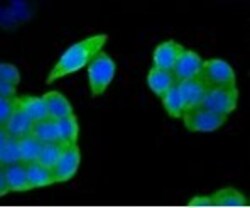
- Experimental details
- Immunofluorescence analysis of HAPLN1 in SW480 cells (green). Samples were treated with paraformaldehyde, permeabilized with 0.25% Triton and PBS, and incubated with HAPLN1 monoclonal antibody (Product # MA5-24856).
- Submitted by
- Invitrogen Antibodies (provider)
- Main image
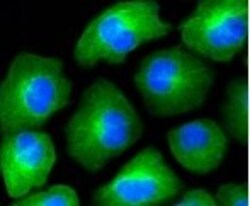
- Experimental details
- Immunofluorescence analysis of HAPLN1 in HUVEC cells (green). Samples were treated with paraformaldehyde, permeabilized with 0.25% Triton and PBS, and incubated with HAPLN1 monoclonal antibody (Product # MA5-24856).
- Submitted by
- Invitrogen Antibodies (provider)
- Main image
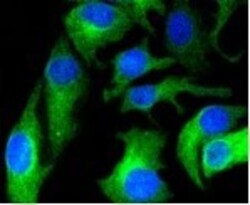
- Experimental details
- Immunofluorescence analysis of HAPLN1 in BT-20 cells (green). Samples were treated with paraformaldehyde, permeabilized with 0.25% Triton and PBS, and incubated with HAPLN1 monoclonal antibody (Product # MA5-24856).
- Submitted by
- Invitrogen Antibodies (provider)
- Main image
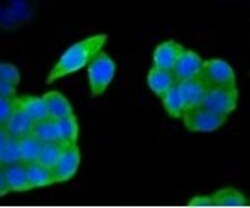
- Experimental details
- Immunofluorescence analysis of HAPLN1 in SW480 cells (green). Samples were treated with paraformaldehyde, permeabilized with 0.25% Triton and PBS, and incubated with HAPLN1 monoclonal antibody (Product # MA5-24856).
- Submitted by
- Invitrogen Antibodies (provider)
- Main image
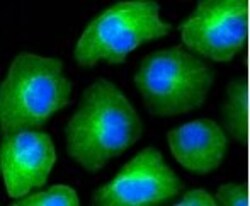
- Experimental details
- Immunofluorescence analysis of HAPLN1 in HUVEC cells (green). Samples were treated with paraformaldehyde, permeabilized with 0.25% Triton and PBS, and incubated with HAPLN1 monoclonal antibody (Product # MA5-24856).
- Submitted by
- Invitrogen Antibodies (provider)
- Main image
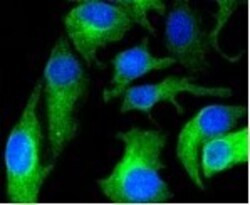
- Experimental details
- Immunofluorescence analysis of HAPLN1 in BT-20 cells (green). Samples were treated with paraformaldehyde, permeabilized with 0.25% Triton and PBS, and incubated with HAPLN1 monoclonal antibody (Product # MA5-24856).
Supportive validation
- Submitted by
- Invitrogen Antibodies (provider)
- Main image
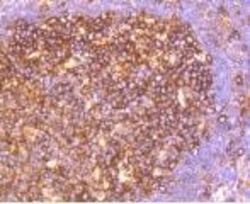
- Experimental details
- Immunohistochemistry analysis of HAPLN1 in paraffin-embedded human tonsil tissue. Samples were incubated with HAPLN1 monoclonal antibody (Product # MA5-24856) followed by hematoxylin.
- Submitted by
- Invitrogen Antibodies (provider)
- Main image
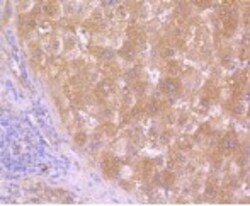
- Experimental details
- Immunohistochemistry analysis of HAPLN1 in paraffin-embedded human liver tissue. Samples were incubated with HAPLN1 monoclonal antibody (Product # MA5-24856) followed by hematoxylin.
- Submitted by
- Invitrogen Antibodies (provider)
- Main image
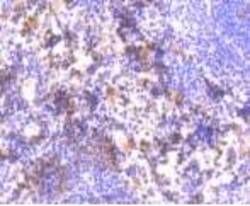
- Experimental details
- Immunohistochemistry analysis of HAPLN1 in paraffin-embedded mouse spleen tissue. Samples were incubated with HAPLN1 monoclonal antibody (Product # MA5-24856) followed by hematoxylin.
- Submitted by
- Invitrogen Antibodies (provider)
- Main image
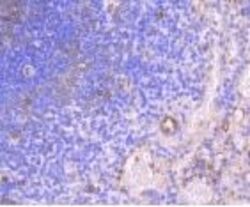
- Experimental details
- Immunohistochemistry analysis of HAPLN1 in paraffin-embedded human spleen tissue. Samples were incubated with HAPLN1 monoclonal antibody (Product # MA5-24856) followed by hematoxylin.
Supportive validation
- Submitted by
- Invitrogen Antibodies (provider)
- Main image
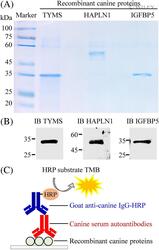
- Experimental details
- 1 FIGURE Production of recombinant canine proteins for detection of circulating corresponding autoantibodies in canine sera. A, Recombinant canine TYMS, HAPLN1 and IGFBP5 proteins purified from E. coli BL21(DE3) (1 mug each) were resolved by SDS-PAGE with a 4% to 20% gradient polyacrylamide gel and sequentially stained with InstantBlue. B, Recombinant canine proteins were confirmed by immunoblotting (IB) with specific antibodies as indicated. C, Schematic of a serological ELISA established for detection of serum autoantibodies. HAPLN1, hyaluronan and proteoglycan link protein 1; HRP, horseradish peroxidases; IGFBP5, insulin-like growth factor-binding protein 5; TMB, tetramethylbenzidine; TYMS, thymidylate synthetase [Colour figure can be viewed at wileyonlinelibrary.com ]
 Explore
Explore Validate
Validate Learn
Learn Western blot
Western blot Immunocytochemistry
Immunocytochemistry